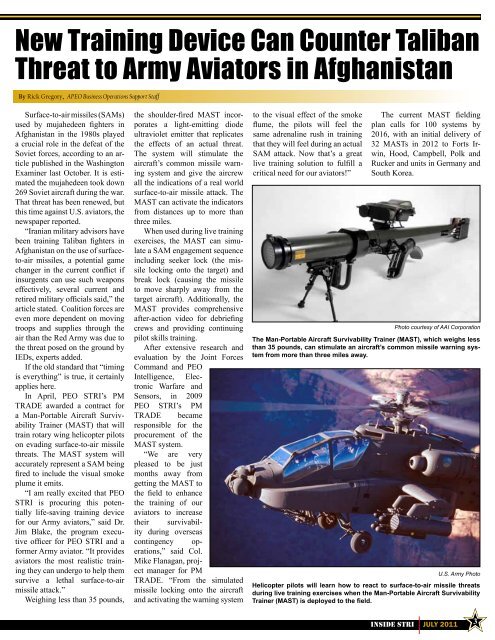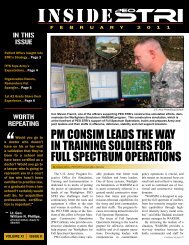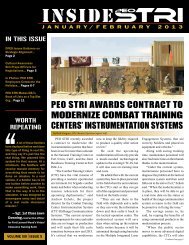InsIde - PEO STRI - U.S. Army
InsIde - PEO STRI - U.S. Army
InsIde - PEO STRI - U.S. Army
You also want an ePaper? Increase the reach of your titles
YUMPU automatically turns print PDFs into web optimized ePapers that Google loves.
New Training Device Can Counter Taliban<br />
Threat to <strong>Army</strong> Aviators in Afghanistan<br />
By Rick Gregory, A<strong>PEO</strong> Business Operations Support Staff<br />
Surface-to-air missiles (SAMs)<br />
used by mujahedeen fighters in<br />
Afghanistan in the 1980s played<br />
a crucial role in the defeat of the<br />
Soviet forces, according to an article<br />
published in the Washington<br />
Examiner last October. It is estimated<br />
the mujahedeen took down<br />
269 Soviet aircraft during the war.<br />
That threat has been renewed, but<br />
this time against U.S. aviators, the<br />
newspaper reported.<br />
“Iranian military advisors have<br />
been training Taliban fighters in<br />
Afghanistan on the use of surfaceto-air<br />
missiles, a potential game<br />
changer in the current conflict if<br />
insurgents can use such weapons<br />
effectively, several current and<br />
retired military officials said,” the<br />
article stated. Coalition forces are<br />
even more dependent on moving<br />
troops and supplies through the<br />
air than the Red <strong>Army</strong> was due to<br />
the threat posed on the ground by<br />
IEDs, experts added.<br />
If the old standard that “timing<br />
is everything” is true, it certainly<br />
applies here.<br />
In April, <strong>PEO</strong> <strong>STRI</strong>’s PM<br />
TRADE awarded a contract for<br />
a Man-Portable Aircraft Survivability<br />
Trainer (MAST) that will<br />
train rotary wing helicopter pilots<br />
on evading surface-to-air missile<br />
threats. The MAST system will<br />
accurately represent a SAM being<br />
fired to include the visual smoke<br />
plume it emits.<br />
“I am really excited that <strong>PEO</strong><br />
<strong>STRI</strong> is procuring this potentially<br />
life-saving training device<br />
for our <strong>Army</strong> aviators,” said Dr.<br />
Jim Blake, the program executive<br />
officer for <strong>PEO</strong> <strong>STRI</strong> and a<br />
former <strong>Army</strong> aviator. “It provides<br />
aviators the most realistic training<br />
they can undergo to help them<br />
survive a lethal surface-to-air<br />
missile attack.”<br />
Weighing less than 35 pounds,<br />
the shoulder-fired MAST incorporates<br />
a light-emitting diode<br />
ultraviolet emitter that replicates<br />
the effects of an actual threat.<br />
The system will stimulate the<br />
aircraft’s common missile warning<br />
system and give the aircrew<br />
all the indications of a real world<br />
surface-to-air missile attack. The<br />
MAST can activate the indicators<br />
from distances up to more than<br />
three miles.<br />
When used during live training<br />
exercises, the MAST can simulate<br />
a SAM engagement sequence<br />
including seeker lock (the missile<br />
locking onto the target) and<br />
break lock (causing the missile<br />
to move sharply away from the<br />
target aircraft). Additionally, the<br />
MAST provides comprehensive<br />
after-action video for debriefing<br />
crews and providing continuing<br />
pilot skills training.<br />
After extensive research and<br />
evaluation by the Joint Forces<br />
Command and <strong>PEO</strong><br />
Intelligence, Electronic<br />
Warfare and<br />
Sensors, in 2009<br />
<strong>PEO</strong> <strong>STRI</strong>’s PM<br />
TRADE became<br />
responsible for the<br />
procurement of the<br />
MAST system.<br />
“We are very<br />
pleased to be just<br />
months away from<br />
getting the MAST to<br />
the field to enhance<br />
the training of our<br />
aviators to increase<br />
their survivability<br />
during overseas<br />
contingency operations,”<br />
said Col.<br />
Mike Flanagan, project<br />
manager for PM<br />
TRADE. “From the simulated<br />
missile locking onto the aircraft<br />
and activating the warning system<br />
to the visual effect of the smoke<br />
flume, the pilots will feel the<br />
same adrenaline rush in training<br />
that they will feel during an actual<br />
SAM attack. Now that’s a great<br />
live training solution to fulfill a<br />
critical need for our aviators!”<br />
The current MAST fielding<br />
plan calls for 100 systems by<br />
2016, with an initial delivery of<br />
32 MASTs in 2012 to Forts Irwin,<br />
Hood, Campbell, Polk and<br />
Rucker and units in Germany and<br />
South Korea.<br />
Photo courtesy of AAI Corporation<br />
The Man-Portable Aircraft Survivability Trainer (MAST), which weighs less<br />
than 35 pounds, can stimulate an aircraft’s common missile warning system<br />
from more than three miles away.<br />
U.S. <strong>Army</strong> Photo<br />
Helicopter pilots will learn how to react to surface-to-air missile threats<br />
during live training exercises when the Man-Portable Aircraft Survivability<br />
Trainer (MAST) is deployed to the field.<br />
Inside <strong>STRI</strong> JUly 2011 3
















